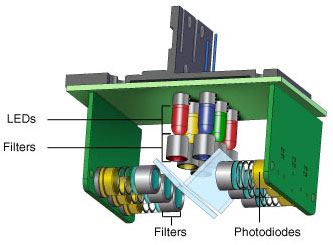Characteristics of PCR LED light source
PCR LED light source plays an important role in PCR (polymerase chain reaction) technology. Its characteristics and applications can be summarized as follows:
1. Characteristics of PCR LED light source
High efficiency and energy saving:
LED light source has high efficiency of power conversion efficiency, which can directly convert electrical energy into light energy, reducing energy loss.
Compared with traditional light sources (such as halogen lamps), LED light source has lower energy consumption, which helps to save energy and reduce operating costs.
Long life:
The luminous mechanism of LED light source determines its long service life, which can usually reach tens of thousands of hours, much higher than traditional light sources.
Long life means reducing the frequency of replacing light source and reducing maintenance costs.
Good stability:
The output light intensity of LED light source is stable and not easily affected by external environment (such as temperature and humidity), which ensures the accuracy and reliability of PCR experiment.
Excellent spectral characteristics:
The spectral range of LED light source is narrow, which can provide light of specific wavelength, suitable for exciting specific fluorescent markers.
In PCR experiment, choosing LED light source with appropriate wavelength can maximize the excitation of target fluorescent signal and reduce the interference of background noise.
Environmental protection and no pollution:
LED light source is a fully solid light source, does not contain harmful elements such as mercury, and waste can be recycled, which meets environmental protection requirements.
2. Application of PCR LED light source

Fluorescence quantitative PCR:
In fluorescence quantitative PCR, LED light source, as an important component of the light source module, is responsible for providing light energy to excite fluorescent-labeled primers and probes to emit fluorescent signals.
Stable light source output and appropriate light intensity are essential to ensure the stability of fluorescent signals and improve detection sensitivity.
Rapid PCR detection:
In recent years, new LED-based PCR systems have been developed, which use the rapid heating characteristics of LED to accelerate the thermal cycling process of PCR, thereby achieving rapid delivery of detection results.
This system is easy to operate and low-cost, suitable for instant detection scenarios, and helps clinicians quickly assess patients’ conditions and develop treatment plans.
Other PCR-related applications:
In addition to fluorescence quantitative PCR and rapid PCR detection, LED light sources can also be used in other PCR-related applications that require light excitation, such as visual detection of PCR products.
3. Summary
PCR LED light sources have been widely used in PCR technology due to their high efficiency and energy saving, long life, good stability, excellent spectral characteristics, and environmental protection and pollution-free. With the continuous advancement and innovation of science and technology, the performance of PCR LED light sources will be further improved, providing more reliable and efficient light source solutions for PCR experiments and related applications.












